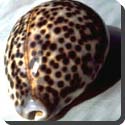 Cowrie shells are widely distributed and possibly the favourites among shell collectors because of their polished enamel-like surfaces and their beautiful colored patterns. The cowrie appears in all the warmer seas of the globe. But the great cowries, the tiger cowrie and the orange cowrie are natives of tropical regions. They crawl slowly, browsing on weeds, and are shy creatures remaining hidden during the day in crevices or under rocks.
Cowrie shells are widely distributed and possibly the favourites among shell collectors because of their polished enamel-like surfaces and their beautiful colored patterns. The cowrie appears in all the warmer seas of the globe. But the great cowries, the tiger cowrie and the orange cowrie are natives of tropical regions. They crawl slowly, browsing on weeds, and are shy creatures remaining hidden during the day in crevices or under rocks.
The best-known and most popular is the tiger cowrie. The shell grows about four inches long as is covered with spots. It was used by 18th century silversmiths to make shell snuff-boxes and in Italy for burnishing paper and ironing lace. The shells were often distributed in Europe by sailors and gypsies.
Orange cowries at one time sold for large sums on the market. In Fiji and the New Hebrides in the Pacific they are still worn as badges of rank by the chiefs.
The money cowrie is a small oval shell, flat and white underneath with thick yellowish-white edges and a pale lemon upper surface. It is found in enormous quantities in the Pacific, from the Moluccas eastward. Large fortunes were at one time made by European traders who transported shells to the west coasts of Africa and exchanged them for ivory, gold and slaves. A slave would be worth anything from 20,000 to 50,000 shells. In 1849 money cowries weighing 240 tons were imported into the English port of Liverpool.
A man at Cuttack in Orissa, India, paid for the erection of his bungalow entirely in cowries. The building cost him £400, which in cowries amounted to 16,000,000 shells. The common method of handling the cowries was by threading them on a string, 40 cowries to one string.
Among the cowries the rarest is Cypreae leucedon. Only two known examples of this pale brown, creamy-spotted shell exist. One is in the British Museum, the other in the Harvard University Museum. More than 190 species of cowrie shell are known to collectors. Some species are used as charms against evil spirits.
 Kids Portal For Parents India Kids Network
Kids Portal For Parents India Kids Network






